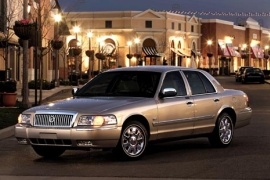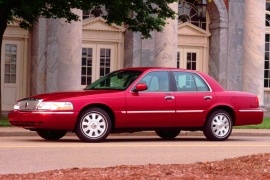MERCURY Grand Marquis Models/Series Timeline, Specifications & Photos
First production year: 2002
Engines: Gasoline
Ford introduced the fourth generation of the Mercury Grand Marquis in 2003 and, four years later, it had to update the model.
With a world financial crisis that cut jobs and wiped-out brands like they have never existed, the carmakers' biggest problem was not how to increase their revenue but how to survive. Ford desperately tried to survive and sold Volvo, Aston Martin, Jaguar, Land Rover and Mazda. The blue-oval brand, with over a century of experience, survived after two world wars and a few other major crises. But the 2007 one was the harshest. In a desperate attempt to keep the Mercury brand alive, Ford stopped its Crown Victoria and diverted its customers toward the Grand Marquis, which received a facelifted version.
But Mercury didn't die without a fight and put the Grand Marquis on the map with Crown Victoria features, good for families. The car brand didn't care about its luxury-oriented customers and cared more about those who couldn't afford a Mercury before but still tried to get one. For them, the Grand Marquis was a great deal. It was offered in only one trim option but well finished and with many features inside. On the outside, there were minor modifications that included the additional fog lights under the front bumper.
Inside, the main change was for the instrument panel, which featured a trip computer and the addition of a tachometer. The Grand Marquis was one of the last vehicles built by Ford without one.
But despite all the modifications, the last Grand Marquis rolled-out from the assembly lines on January 4, 2011. It was also the last Mercury built.
Mercury introduced a so-called fourth generation of the Grand Marquis in 2002, but it was more of a restyling of the previous 1998 generation.
While it wasn't as famous as its sibling, Ford Crown Victoria, the Grand Marquis was designed as a much more luxurious model. Moreover, this generation overtook its sibling, the Cougar, in terms of Mercury's longest production nameplate. This achievement was possible thanks to the Grand Marquis's many qualities.
There was no denying that the overall car's look was outdated. Still, its classic design seemed to reach traditional customers who didn't like the new-edge design trend or some other futuristic approaches of carmakers. It featured horizontal, squared headlights that flanked a slightly taller, chromed radiator grille with vertical slats. The corner-mounted turn signals featured a smaller amber lens placed horizontally at the bottom instead of its predecessor's usual, tall ones. At the back, the chromed slat mounted on the lower side of the taillights was deleted. Instead, Mercury kept the chromed trim on the side cladding and on the bumpers for specific trim levels.
Inside, the dashboard sported a slightly curved upper side covering the instrument cluster and the stereo. At the same time, the climate control panel was placed lower on the center stack. Mercury didn't want to completely ditch the bench seat for the front occupants. Still, it offered an option for two extra-wide seats that formed a bench, with the only difference that these two sides could have been controlled independently.
Ford placed the same modular 4.6-liter V8 engine as before, but it made it available in two versions: 224 hp and 239 hp. The latter was for export markets, and both were paired to a four-speed automatic transmission.

